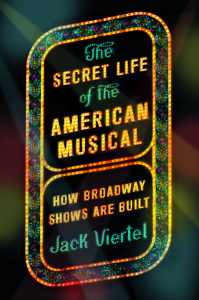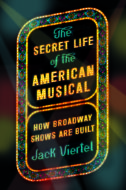Book Review: The Secret Life of the American Musical: How Broadway Shows Are Built
The Secret Life of the American Musical: How Broadway Shows Are Built.
Jack Viertel
New York, NY: Sarah Crichton Books, 2016
ISBN 978-0374256920
336 p.
Even long-time Shubert Alley denizens will be entertained and enlightened by veteran producer/dramaturge Viertel’s keen yet charming explication and analysis of the inner workings of a typical Broadway musical. The word “built” in this book’s subtitle is very fitting, as, with humor and panache, Viertel reveals the strategy and structure behind what is heard and why it’s heard within a musical’s performance.
Viertel does this cleverly, by lining up his chapters in the same sequence as a show’s unspooling elements. He begins with an overture, then on to the opening number. From there, we move to what he characterizes as an “I Want” song for the lead character (such as “The Wizard and I” from Wicked ) then on to so-called “conditional love songs,” (“I’ll Know” from Guys and Dolls) “tent poles,” (“Tevye’s Dream” from Fiddler On The Roof), and first act closings.
Finally, we have chapters corresponding to the second act’s “main event,” the crucial “next-to-last scene” (Louise and Rose’s final conversation in Gypsy), the ending, and the curtain call. There’s even an interlude chapter discussing the art of intermissions.
In each chapter, Viertel offers plentiful examples to illustrate the guaranteed method behind the madness of musical theatre creation. While such method may prove more successful in some shows than in others (and he offers some possible reasons for this), a given musical’s undergirding framework is nevertheless always there to respect and appreciate.
Viertel bathes his readers in appreciative nostalgia as he dissects many of the finest musical theatre classics ever created. For him, these include Guys and Dolls, West Side Story, Oklahoma!, Fiddler On the Roof, Music Man, Funny Thing Happened/Forum, King & I, Pajama Game, Gypsy, and Carousel,
But his perspective ranges widely: he also embraces more recent contributions to Broadway such as Hairspray, Company, Rent, City of Angels, Chorus Line, Little Shop of Horrors, The Producers, The Wedding Singer, Caroline or Change, and Spring Awakening. Finally, he tips his hat with affection and admiration to Wicked, The Book of Mormon, and Hamilton.
As a fine appendix to his discussion, Viertel also offers thumbnail evaluations of each of his spotlighted shows’ cast albums, and includes recordings from those few shows not thoroughly analyzed within his text. These opinionated snippets are as substantive and entertainingly presented as his preceding chapters.
Thanks to Jack Viertel, theatregoers will likely never again experience a musical in quite the same way, but that’s not a bad fate at all. This book is highly recommended for all performing arts/theatre collections and for general readers with Broadway show tunes in their hearts.
Catherine Ritchie
Dallas (TX) Public Library

